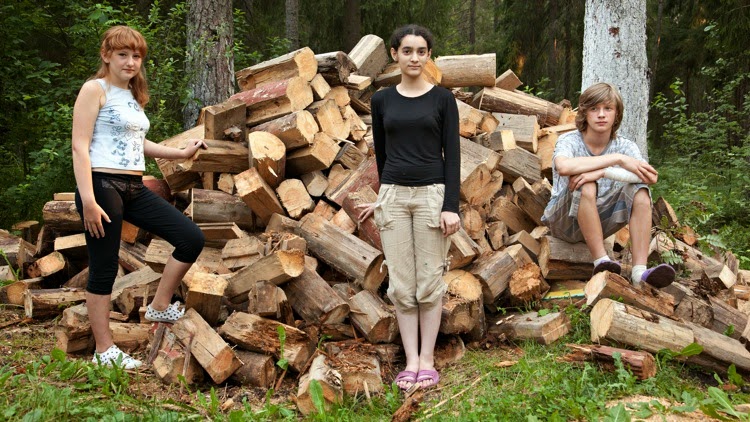We
hope you’ve enjoyed watching the progress of our film opening
Group 1 - Seb, Vivian, Louis, Mari
Film Opening
Friday, 4 April 2014
Note To Moderator
Hello and welcome to our group Foundation Production Blog.
Thank you for taking time to look around! The best way to navigate around our
blog is by clicking on the labels on the right hand side of the page.
Under the Research and Planning label, you will find evidence of all the research, planning and development work we did as a group during the pre-production, production and post-production stages of our project.
In order for you to see exactly what each candidate contributed to this process, we have also included Individual Contribution labels named for each group member. All research, planning and development posts contributed to by the named candidate will appear when you click that label.
Each member of the group has also completed their own evaluation although we have collaborated to produce some of the content, such as our voice overs. You can access our responses to the evaluation questions under the individually named Evaluation labels.
Our finished Film Opening Sequence is at the top of the blog, and each candidate has posted their Preliminary Task Video Sequence as part of their answer to Q7 Evaluation.
You can also filter our posts by labels or date, and there is a blog archive if you want to look through chronologically.
You will also find a link to the Class Film Blog which contains links to the other group blogs from our school.
(Please note the 'Older Posts' bottom at the bottom of each page)
Once again, thank you for your time - we hope you enjoy looking around the blog as much as we enjoyed creating it!
From Vivian Oparah, Mari Leach, Seb Hodge and Louis Caldwell
Under the Research and Planning label, you will find evidence of all the research, planning and development work we did as a group during the pre-production, production and post-production stages of our project.
In order for you to see exactly what each candidate contributed to this process, we have also included Individual Contribution labels named for each group member. All research, planning and development posts contributed to by the named candidate will appear when you click that label.
Each member of the group has also completed their own evaluation although we have collaborated to produce some of the content, such as our voice overs. You can access our responses to the evaluation questions under the individually named Evaluation labels.
Our finished Film Opening Sequence is at the top of the blog, and each candidate has posted their Preliminary Task Video Sequence as part of their answer to Q7 Evaluation.
You can also filter our posts by labels or date, and there is a blog archive if you want to look through chronologically.
You will also find a link to the Class Film Blog which contains links to the other group blogs from our school.
(Please note the 'Older Posts' bottom at the bottom of each page)
Once again, thank you for your time - we hope you enjoy looking around the blog as much as we enjoyed creating it!
From Vivian Oparah, Mari Leach, Seb Hodge and Louis Caldwell
Thursday, 3 April 2014
1. In what ways does your media product use, develop or challenge forms and conventions of real media products?
We decided we wanted to make a film of the urban drama genre with coming of age themes; from this our narrative developed into a modern portrayal of Romeo and Juliet set in British inner cities. The following powerpoint shows the theories and real media examples we used when constructing our opening... (make sure you start from slide 1)
2. How does your media represent particular social groups
The social groups presented in our film are class and age.
Class
The class groups we focused on were the working class and middle class
- Working Class
Melissa, her friends and family represent this class group.
Melissa is a positive representation of her class groups, the opening shows her looking after her family; "I have to go and get my dads medicine", and does not hold prejudices towards other class groups- hence falling for Clem, a middle class boy.
We purposely chose to contrast her with the portrayal of her friend Shani, who conforms to the presentation of the sassy mixed race girl stereotype often portrayed in film and TV, for example the character Shania Andews from "Fast Girls" (2012):
The trailer presents her as feisty and angry through her body language and script
- Body Language, raising eye brows

- Script
"I'm not very good with teams" (antisocial)
"What the hell was that!?"
Similarly when creating the characters Shani we used facial expressions and dialog to convey character trait
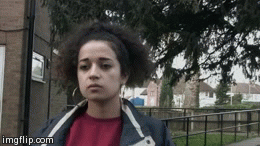
- The eye roll and raised eye brow do this
Script - "Shut up man, you're always complaining"
- Middle Class
Represented by Louis
Influenced by the portrayal of middle class teenagers in the TV Drama Skins
He does not act posh, but has the money to be selective about the life style he leads and the hobbies he takes up, e.g. skateboarding.
Age
The main age group our film will focus on our teenagers...
By showing the two teenagers become attracted to each other, despite their different class backgrounds, show how they are well adapted to diverse modern society and can look past social barriers. This positive portrayal of youth behaving maturely and peacefully with each other, contrast the representation in the media and the viewpoint of adults as violent and antisocial.
This is enhanced by our portrayal of the older characters later on in the film. Melissas' family( older brothers and parents) disapprove of their relationship due to their prejudices.
Class
The class groups we focused on were the working class and middle class
- Working Class
Melissa, her friends and family represent this class group.
Melissa is a positive representation of her class groups, the opening shows her looking after her family; "I have to go and get my dads medicine", and does not hold prejudices towards other class groups- hence falling for Clem, a middle class boy.
We purposely chose to contrast her with the portrayal of her friend Shani, who conforms to the presentation of the sassy mixed race girl stereotype often portrayed in film and TV, for example the character Shania Andews from "Fast Girls" (2012):
.jpg) |
| Shania Andrews- Fast Girls |
- Body Language, raising eye brows

- Script
"I'm not very good with teams" (antisocial)
"What the hell was that!?"
Similarly when creating the characters Shani we used facial expressions and dialog to convey character trait

- The eye roll and raised eye brow do this
Script - "Shut up man, you're always complaining"
- Middle Class
Represented by Louis
Influenced by the portrayal of middle class teenagers in the TV Drama Skins
In particular the character Freddie...
He does not act posh, but has the money to be selective about the life style he leads and the hobbies he takes up, e.g. skateboarding.
Age
The main age group our film will focus on our teenagers...
By showing the two teenagers become attracted to each other, despite their different class backgrounds, show how they are well adapted to diverse modern society and can look past social barriers. This positive portrayal of youth behaving maturely and peacefully with each other, contrast the representation in the media and the viewpoint of adults as violent and antisocial.
 |
| Headline from guardian website |
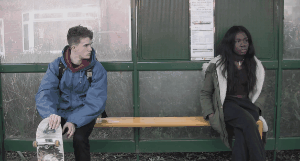 |
| First love |
This is enhanced by our portrayal of the older characters later on in the film. Melissas' family( older brothers and parents) disapprove of their relationship due to their prejudices.
3. What kind of media institution are most likely to produce your media and why
The media institutions behind our film: Film 4 (funding), Pigeon Productions (producers) and Revolver Entertainment (Distributors)

Furthermore we found that previous films produced and distributed by Film4 shared similar themes with our film.
These films focus on gratifying audiences need to learn (uses and gratifications theory), a common aspect of independently produced films as opposed to Hollywood films, we also want our film to be thought provoking.
Film 4
We felt that Film 4 would be the kind of media institution that would fund and back our film as it complied with their commissioning priorities: "contemporary", "British led talent", "British content", "push boundaries"Furthermore we found that previous films produced and distributed by Film4 shared similar themes with our film.
These films focus on gratifying audiences need to learn (uses and gratifications theory), a common aspect of independently produced films as opposed to Hollywood films, we also want our film to be thought provoking.
Pigeon Productions
 |
| Pigeons are symbolic of gritty, dirty, city life |
Pigeon Productions is our made up production company, specializing in films of the urban drama genre.
Based on real production companies such as Cipher Films (Kidulthood, Adulthood) independent British film producers.
1st EVER DAY & DATE THEATRICAL RELEASE
1st EVER LIVE ACTION 3D RELEASE
1st EVER ONLINE Q&A
1st EVER ONLINE MOVIE PREMIER
1st EVER FILM MOBILE APP ON ALL MAJOR PLATFORMS
Leaders in the field of social media marketing and building of online communities Revolver boasts over 680,000 "likes" across its recent new releases, over 9 million Youtube trailer views and over 2.5 million music video trailer views."
Revolver Entertainment
Independent UK Distributing companyWhy they would be the right distributor for us...
- Encourages and supports fresh, new ideas
" At our core is a spirit of pioneering innovation that has led Revolver to achieve a catalogue of industry firsts. It is an ethos that informs every aspect of the business and one which is most evident in the unique approach taken to managing its enviable slate of edgy theatrical and home entertainment releases."
" At our core is a spirit of pioneering innovation that has led Revolver to achieve a catalogue of industry firsts. It is an ethos that informs every aspect of the business and one which is most evident in the unique approach taken to managing its enviable slate of edgy theatrical and home entertainment releases."
- Specialise in marketing techniques that would reach our target audience
" While a theatrical focus is key to Revolver's business they are also experts in youth entertainment and exploiting both physical and digital home entertainment distribution channels. In a time of industry change Revolver remain at the forefront of possibility as pioneers in digital distribution, embracing new technology and always staying one step ahead of the game:
" While a theatrical focus is key to Revolver's business they are also experts in youth entertainment and exploiting both physical and digital home entertainment distribution channels. In a time of industry change Revolver remain at the forefront of possibility as pioneers in digital distribution, embracing new technology and always staying one step ahead of the game:
1st EVER DAY & DATE THEATRICAL RELEASE
1st EVER LIVE ACTION 3D RELEASE
1st EVER ONLINE Q&A
1st EVER ONLINE MOVIE PREMIER
1st EVER FILM MOBILE APP ON ALL MAJOR PLATFORMS
Leaders in the field of social media marketing and building of online communities Revolver boasts over 680,000 "likes" across its recent new releases, over 9 million Youtube trailer views and over 2.5 million music video trailer views."
This suggests their marketing strategy would feature new technology such as social media and apps, this would target our audience (16-24 year olds'), as they are the highest users of these technologies. In particular their strong online presence across various social media sites YouTube, Facebook, Twitter and Pinterest, that they have shown to use to promote films in their marketing stage, would be ideal to reach the target audience for "Growing Pains"
 |
| YouTube Page |
 |
| Tweet from their Twitter Page Promoting new film |
Exhibition
As an indie film, "Growing Pains" would most likely show at indie art house cinemas.
However, the target audience (16-24 yrs) are the most prolific cinema goers, so might have a chance at showing at some mainstream cinemas also.
4.Who would be the audience for your media product
Target Audience
The chosen genre of our film was Urban Drama, with coming of age and romantic themes. Therefore the target audience would be male and female young adults (16-24), living in cities and urban areas, as the themes of our film, best relate to them.
- People living in urban environments
The "Urban Drama" genre means our films depicts what it is like to live in an urban environment. Our film shows how people of different ages deal with social class barriers, as diversity is a key part of city life. Therefore in order to best relate to these issues, the audience would be living urban areas, where they can recognise these issues.
Although our presentation of urban areas, is based on own knowledge, which is largely influenced by where we live- London, our film opening is shot in an urban environment just out of London (Cheshunt). We understood that there are many cities across the UK in which the issues our film raises are relevant, therefore by shooting in iconic London settings we could be disregarding potential audiences.
The Bus Stop
Transport is key to a city and is found in any urban area.
We chose to use the neutral Cheshunt bus stop over the iconic London bus stop to increase audience appeal
We chose to use the neutral Cheshunt bus stop over the iconic London bus stop to increase audience appeal
 |
| TFL Logo |
 |
| Cheshunt Bus Stop |
Young adults (16-24)
As well as urban themes, our film depicts what it is like to be a young adult living in this environment. The most prominent theme is young love, and in the diverse setting of a city, the increased chance of meeting somebody different from you.
Male and female
Neither a girly or macho film, quite neutral. This balance is maintained by having both female and male protagonists. There is also themes that specifically target both these audiences, the romance themes for females and the more violent gang fights (later on in film) for males.
Consumption habits, life style and other media consumed...
A prominently technologically advanced age group, grew up with the proliferating technology. Most people have smart phones, use social media such as Twitter and Facebook, and keep up to date with the latest technological releases. In terms of film, will either watch at home on streaming device e.g. Netflix, go to cinema due to high dispensable income.

Favorite Film and TV...
Fans of other urban drama genre films e.g Kidulthood (2006), Adulthood (2008)
Fans of urban drama TV e.g Top Boy
Fans of Indie films, e.g. Submarine (2010)
Fans of challenging TV e.g. Skins
Fans of high-brid indie urban drama genre films e.g. Fish Tank (2009)
Secondary Audience
- Young teens (14-16) in search of role models.
- Older people (24+) attracted by the idea of a nostalgic teen film, reminder of their youth, they were teenagers once too.
.jpg) |
| Every generation had a youth movie of their time |
5. How did you attract/ address this audience
How do you attract this audience
The soundtrack was key to establishing the urban drama genre, digital sounds are symbolic of modern urban music.
Our sound track:
Feedback from MonkeySurvey shows we were successful at attracting female audience, they specifically mention "I really like the music", "sense the relationship", "use of go pro is good as it sets up the urban drama genre"
They specifically mention "it leaves many questions for the audience", we put these questions in on purpose to keep audiences interested, this theory is known as enigma codes...
Enigma Codes
How do you address this audience
With themes that they can associate with.
e.g. First love
With settings they can identify with
-Urban, as connoted by the bus stop

Critical Target Audience Reactions
This evidence would show we were not successful at addressing the male audience, as their need to identity (uses and gratifications theory) is limited to only one character (Clem). Since this clashes with other feedback from girls who seemed to want "less skateboarding shots", it would seem attracting both audiences was ambitious. If I did the task again the female audience would be the prime audience.
A YouTube screen capture of the geography of our audience, tells us that 99% of our views come from Great Britain.
A YouTube screen capture of the geography of our audience, tells us that 99% of our views come from Great Britain.
 |
| YouTube screen capture |
6. What have you learnt about technologies in the process of producing this product
Pre Production
AnimaticUsed Adobe Premier Pro to create an Animatic i.e. a Story board with sound. This allowed us to spot which shots worked well next to each other and the most effective way to tell the opening narrative.
Our Animatic:
Communication
Used social media to talk to group members an actors. Utilising this social media platform proved to be very useful as everyone on the chat had smart phones therefore replies were instant and direct.
In the commentary below, Louis, Seb and I talk about; GoPro (Production), Sound (Editing) and Grading (Editing).
Production
We experimented placing it on different parts of the skateboard:
| Front of skateboard |
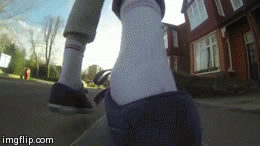 |
| Back of skateboard |
We decided front, so you could see a view of the setting rather than a foot.
In reflection I think the Go Pro was successful, it made the naturalistic opening more interesting to watch as it provided a different range of shots and viewpoints. It was also easy to use- it was simple to attach and we could watch back footage simultaneously on either the GoPro App or the attachable screen.
Post production
Grading
Used the ProcAmp and Three-Way colour corrector on Adobe Premier Pro to create a darker tone to our final edit. This increased its' connection with the urban drama genre. Our main media reference for this was TV drama Misfits.
Used the ProcAmp and Three-Way colour corrector on Adobe Premier Pro to create a darker tone to our final edit. This increased its' connection with the urban drama genre. Our main media reference for this was TV drama Misfits.
ProcAmp allowed you to create the right mix of brightness, contrast, hue and saturation
 |
| ProcAmp |
The three way colour corrector allowed you to create cooler or warmer colours e.g. cool = towards blue green.
 |
| Three way color corrector |
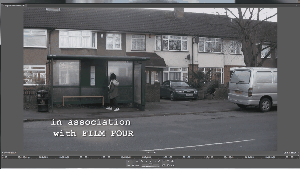 |
| Before and after grading |
Tuesday, 1 April 2014
7. Looking back at your preliminary task what do you feel you have learnt in the progression from it to full product
Preliminary task brief:
"Continuity task involving filming and editing a character opening a door, crossing a room and sitting down in a chair opposite another character, with whom she/he exchanges a couple lines of dialog. This task should demonstrate match on action, shot/reverse/shot and the 180 degree rule."
Finished Prelim:
Main Task brief:
The titles and opening of a new fiction film to last a maximum of two minutes. All video and audio material must be original, produced by the candidate(s), with the exception of music or audio effects from a copyright free source.
We also had to decide on a genre and target audience for the film, an aspect of film making.
Genre
The decision on film genre was largely based on what we thought was achievable with our resources. One of the main factors that led us to decided on the urban drama genre was that Louis (a member of the group) could skateboard.
Target Audience
We wanted to chose a target audience we understood so we could meet their needs, the final decisions was teenagers (16-24)
As using this technology was new for all of us, we researched on You Tube how to attach it to skateboards, and videos made using GoPro, to see the effects on audience. As well as learning how to use it, I learnt how to fit it into the films narrative; where it looks best and is most effective.
However for our main task we also learnt how to grade, edit sound and create and design a title sequence using Live Type.
Title Sequence
Film openings all include title sequences, therefore it was demanded in our brief. We learnt how the look, movement and placement of titles can tell their own narrative, and how to knit them into our opening sequence, to enhance the impact of our opening. For us, we wanted static, subtle titles however this too required thought and careful design.
Design: How to create the right amount of subtlety
Our first titles were large, spaced out but thin
Our final titles were smaller and close together but bold. Also we used capitals to highlight names (we spotted this technique in the opening sequence of Somers Town, and thought it would be effective in our sequence)
Placement of Titles
The main priority was that they could be seen, therefore the background would need to be a color that contrasted the white font.
We also decided that every title should be in either the bottom left or right of the page, by doing the same thing repeatedly, audiences would begin to know what to expect, and would therefore not distract from the action but still be noticed.
Timing of Titles
In order to increase impact, timing the titles in with the action was vital.
E.g. When the skateboard hits the ground, the title appears.
"Continuity task involving filming and editing a character opening a door, crossing a room and sitting down in a chair opposite another character, with whom she/he exchanges a couple lines of dialog. This task should demonstrate match on action, shot/reverse/shot and the 180 degree rule."
Finished Prelim:
Main Task brief:
The titles and opening of a new fiction film to last a maximum of two minutes. All video and audio material must be original, produced by the candidate(s), with the exception of music or audio effects from a copyright free source.
Pre Production
Applied from Prelim:
Continuity
Continuity
From our Prelim we learnt to importance of the continuity principles in telling the narrative of the film and in order to suspend audiences' disbelief. We applied our knowledge of the these principles when planning the shoot board for "Growing Pains". For example the use of the "over the shoulder shot" in conversations to establishing character relations.
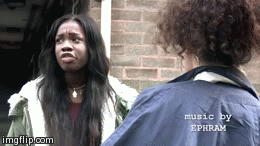
In our prelim, we used the over the shoulder technique to establish the teacher/ pupil relationship. The pupil looks a lot smaller that the teacher.
Our opening establishes that the relationship between the two girls are friends, their relationship is balanced, thus the sizing of the characters is kept equal.
When preparing for the prelim shoot we had to arrange actors, costume, props, setting and script. this process also applied to our film opening.
 |
| Over the shoulder |

In our prelim, we used the over the shoulder technique to establish the teacher/ pupil relationship. The pupil looks a lot smaller that the teacher.
Our opening establishes that the relationship between the two girls are friends, their relationship is balanced, thus the sizing of the characters is kept equal.
When preparing for the prelim shoot we had to arrange actors, costume, props, setting and script. this process also applied to our film opening.
Learnt:
Structure
Structure
However when forming the narrative of our film and film opening we considered a larger range of theories; Todorov's equilibrium theory and Enigma codes.
Before we had taken Todorov's equilibrium theory into consideration, we were going to start our film with the two characters already in a relationship. This would mean the film begins with the disequilibrium, it is possible to do things in that order however in our case the films' narrative would not stand for itself, as once the disequilibrium is resolved the film would be over. Hence the decided structure of our film opening where the camera cuts between the two characters and ends with them meeting.
.jpg) |
| Todorov |
Before we had taken Todorov's equilibrium theory into consideration, we were going to start our film with the two characters already in a relationship. This would mean the film begins with the disequilibrium, it is possible to do things in that order however in our case the films' narrative would not stand for itself, as once the disequilibrium is resolved the film would be over. Hence the decided structure of our film opening where the camera cuts between the two characters and ends with them meeting.
 |
| Thinking up genre ideas |
Genre
The decision on film genre was largely based on what we thought was achievable with our resources. One of the main factors that led us to decided on the urban drama genre was that Louis (a member of the group) could skateboard.
Target Audience
We wanted to chose a target audience we understood so we could meet their needs, the final decisions was teenagers (16-24)
Production
Equiptment- We used the same basic equipment as in the Prelim- Camera (Cannon DVB3), head phones, Microphone and tripod. However for our main task we also learnt how to use the GoPro.
 |
| GoPro |
As using this technology was new for all of us, we researched on You Tube how to attach it to skateboards, and videos made using GoPro, to see the effects on audience. As well as learning how to use it, I learnt how to fit it into the films narrative; where it looks best and is most effective.
 |
| Go Pro Footage |
Post Production
We used the same editing soft ware as in the Prelim- Adobe Premier Pro, and the same tools when cutting the sequence.
.jpg) |
| Adobe Premier Pro |
However for our main task we also learnt how to grade, edit sound and create and design a title sequence using Live Type.
Title Sequence
 |
| Live Type Logo |
Film openings all include title sequences, therefore it was demanded in our brief. We learnt how the look, movement and placement of titles can tell their own narrative, and how to knit them into our opening sequence, to enhance the impact of our opening. For us, we wanted static, subtle titles however this too required thought and careful design.
Design: How to create the right amount of subtlety
Our first titles were large, spaced out but thin
 |
| Tester Title |
Our final titles were smaller and close together but bold. Also we used capitals to highlight names (we spotted this technique in the opening sequence of Somers Town, and thought it would be effective in our sequence)
 |
| Final Title |
Placement of Titles
The main priority was that they could be seen, therefore the background would need to be a color that contrasted the white font.
We also decided that every title should be in either the bottom left or right of the page, by doing the same thing repeatedly, audiences would begin to know what to expect, and would therefore not distract from the action but still be noticed.
Timing of Titles
In order to increase impact, timing the titles in with the action was vital.
E.g. When the skateboard hits the ground, the title appears.
Subscribe to:
Comments (Atom)

.jpg)

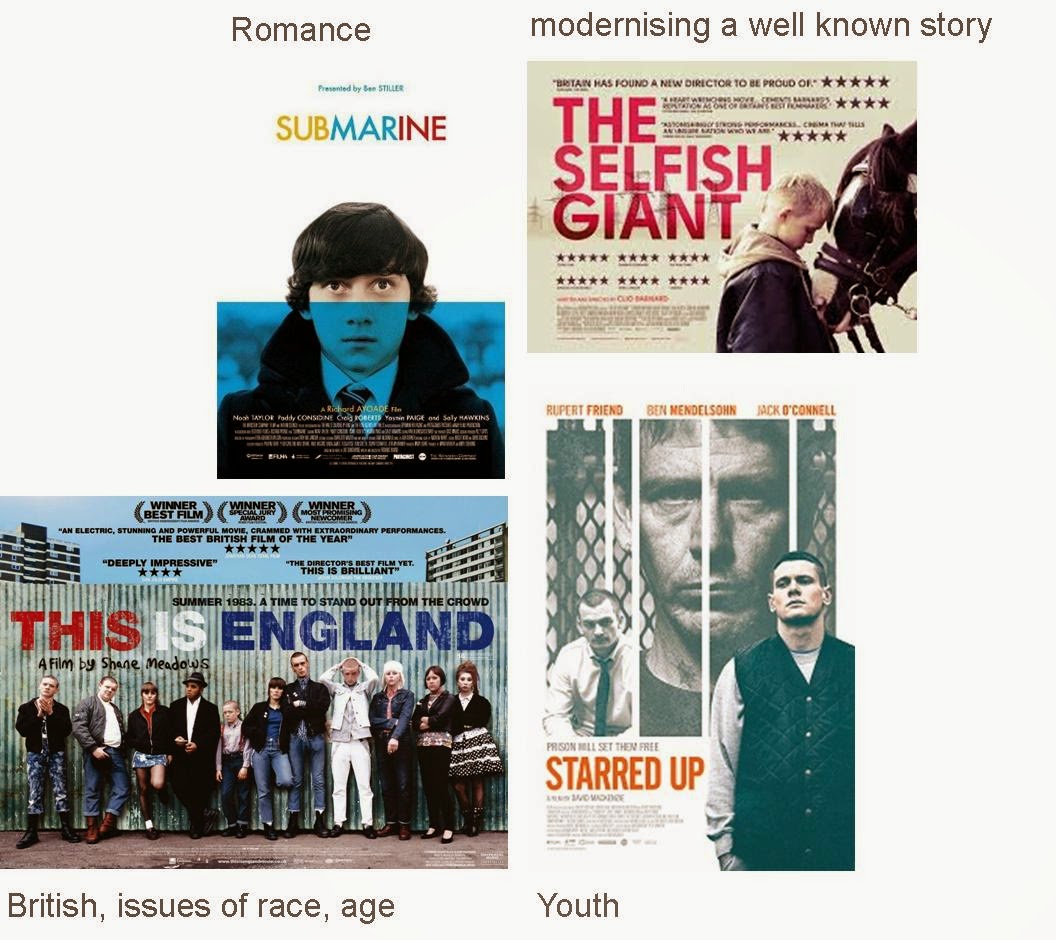



.jpg)

.jpg)

.jpg)
